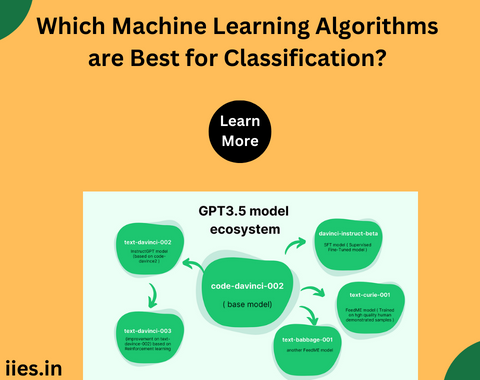
In the vast landscape of machine learning, classification stands as a cornerstone task, where algorithms are employed to assign predefined labels to input data based on its features.
The choice of a suitable classification algorithm is crucial, as it directly influences the accuracy and efficiency of the model.
In this article, we delve into the world of machine learning and unravel some of the best algorithms for classification, considering their strengths, weaknesses, and real-world applications.
Despite its name, logistic regression is a classification algorithm widely used for binary classification problems. It is particularly effective when the relationship between the independent variables and the probability of a specific outcome is approximately linear. Logistic regression models the probability of the occurrence of an event using the logistic function, allowing for easy interpretation of results and providing probabilities rather than definite outcomes.
Applications:
– Spam email detection
– Credit scoring
– Medical diagnosis
Decision Trees:
Decision trees are intuitive and easy-to-understand models that recursively split the data based on features, creating a tree-like structure. Each node in the tree represents a decision based on a feature, leading to the final classification in the leaves. Decision trees are versatile and handle both numerical and categorical data, making them suitable for various scenarios.
Applications:
– Customer churn prediction
– Fraud detection
– Disease diagnosis
Random Forest:
Random Forest is an ensemble learning method that leverages the power of multiple decision trees. It constructs a multitude of trees during training and outputs the mode of the classes for classification problems. Random Forest excels in handling high-dimensional data, mitigating overfitting, and providing robust predictions.
Applications:
– Image classification
– Stock market predictions
– Remote sensing
Support Vector Machines (SVM):
SVM is a powerful algorithm for both binary and multiclass classification tasks. SVM is effective in high-dimensional spaces and is known for its ability to handle non-linear relationships through kernel functions.
Applications:
– Handwriting recognition
– Face detection
– Bioinformatics
k-Nearest Neighbors (k-NN):
k-NN is a simple yet effective algorithm that classifies data points based on the majority class of their k-nearest neighbors. It is a non-parametric and lazy learning algorithm, meaning it doesn’t make assumptions about the underlying data distribution during training. k-NN is particularly useful when dealing with noisy data and doesn’t require training time.
Applications:
– Recommender systems
– Anomaly detection
– Pattern recognition
Naive Bayes:
Naive Bayes is a probabilistic algorithm based on Bayes’ theorem with the assumption of independence between features. It is computationally efficient and requires a small amount of training data.
Applications:
– Spam filtering
– Sentiment analysis
– Document categorization
Neural Networks:
Neural networks, especially deep learning models, have gained significant prominence in recent years for classification tasks. Deep neural networks, with multiple hidden layers, can automatically learn intricate patterns from data. Convolutional Neural Networks (CNNs) excel in image classification, while Recurrent Neural Networks (RNNs) are suitable for sequential data.
Applications:
– Image recognition
– Natural language processing
– Autonomous vehicles
Continued:
Gradient Boosting:
Gradient Boosting is an ensemble method that builds a series of weak learners (usually decision trees) sequentially, with each subsequent tree correcting the errors of the previous ones. This iterative approach enhances model accuracy and is particularly robust against overfitting. Popular implementations of gradient boosting include XGBoost, LightGBM, and AdaBoost.
Applications:
Click-through rate prediction
Customer churn analysis
Fraud detection
Ensemble Methods:
Ensemble methods, as seen in Random Forest and Gradient Boosting, combine multiple models to create a more robust and accurate classifier. The idea is to leverage the strengths of different models and compensate for their individual weaknesses. Ensemble methods often outperform standalone models, making them a preferred choice in various classification scenarios.
Applications:
Predictive maintenance
Financial forecasting
Image segmentation
Gaussian Processes:
Gaussian Processes (GPs) are a probabilistic approach to machine learning, particularly well-suited for small to medium-sized datasets. GPs provide a distribution over functions, allowing them to model uncertainty effectively. While computationally expensive, GPs are valuable in scenarios where understanding prediction uncertainty is crucial.
Applications:
Drug discovery
Geostatistics
Hyperparameter tuning
Extreme Learning Machines (ELM):
ELMs are a type of neural network that differs from traditional deep learning models. They have a single hidden layer and randomly assign weights to connections, skipping the iterative learning process. This results in faster training times and competitive performance, especially in scenarios where computational resources are limited.
Applications:
Image recognition in resource-constrained devices
Real-time prediction systems
Fault detection in industrial processes
The choice of the best machine learning algorithm for classification depends on various factors, including the nature of the data, the complexity of the problem, and the interpretability of the model. Logistic regression is suitable for simpler problems, while complex tasks may benefit from the power of deep learning models. Understanding the strengths and weaknesses of each algorithm empowers data scientists to make informed decisions, ensuring the successful implementation of classification models across diverse domains. As the field of machine learning continues to evolve, the quest for optimal algorithms for classification remains a dynamic and exciting journey.
Indian Institute of Embedded Systems – IIES